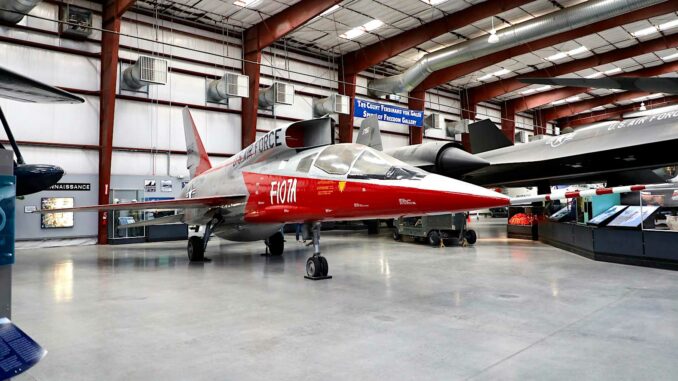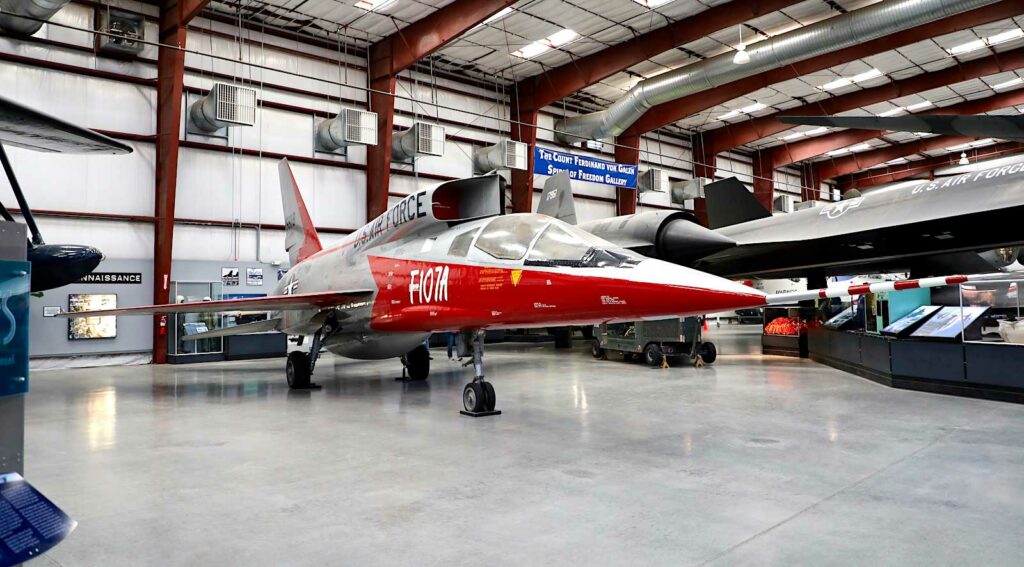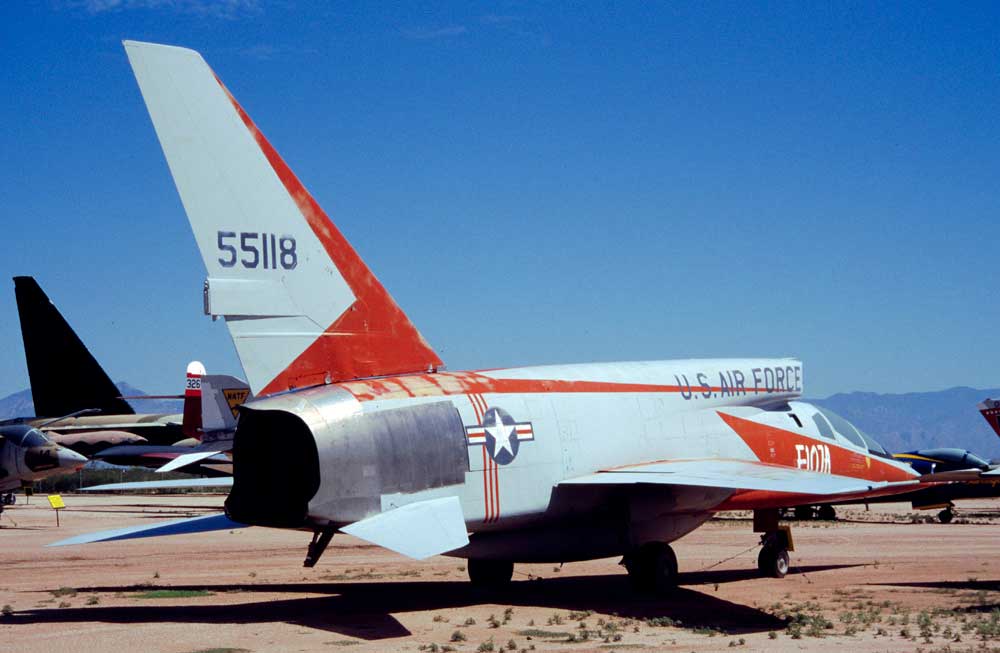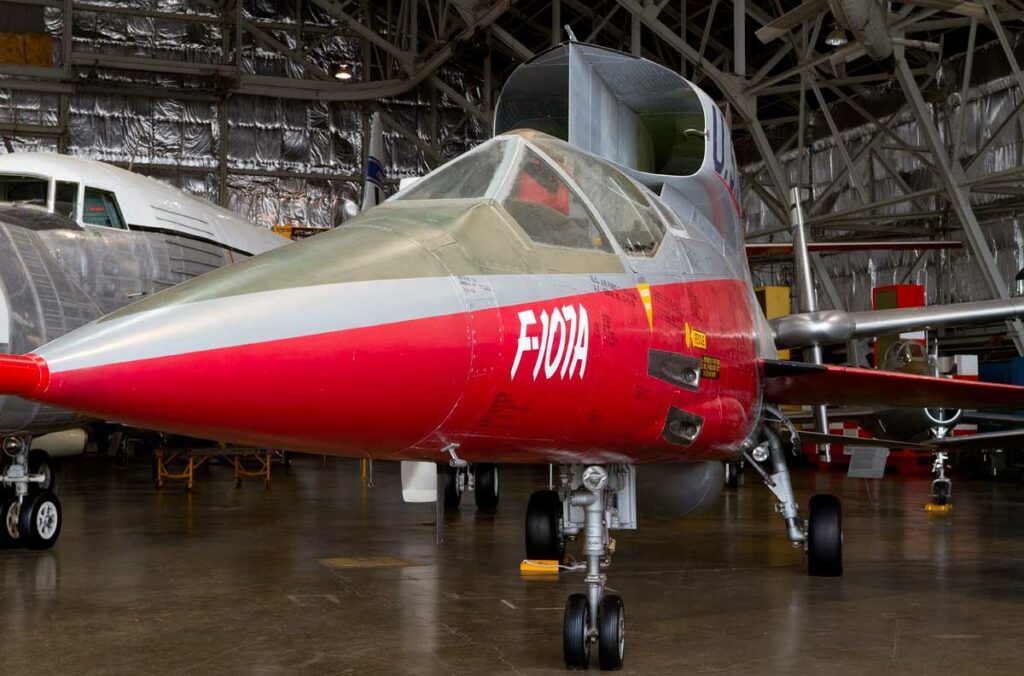
Why did North American place the YF-107’s air intake above the cockpit? Technical analysis of the VAID, its aerodynamic challenges, and its legacy.
In summary
The North American YF-107 remains famous for its dorsal air intake and Variable-Area Inlet Duct system. This choice was made in response to an operational constraint: to house a Mark 7 tactical nuclear weapon under the fuselage in a semi-recessed position without disrupting high-speed separation. The VAID automatically modulated the inlet section to feed the Pratt & Whitney J75 across the entire supersonic range up to Mach 2, while managing shock waves, separation, and distortion at the compressor inlet. This architecture posed challenges: thick boundary layer management at the rear of the fuselage, sensitivity to high angles of attack, and degraded rear visibility, with an impact on ejection ergonomics. Tests validated the effectiveness of the concept and fed into the A-5 Vigilante and XB-70 Valkyrie programs, where variable geometry intake and shock-dilution control were taken further. The experience of the YF-107 still sheds light on how to integrate a ventral bomb bay and supersonic intake.
Operational context and the dorsal option
The tactical requirements of the mid-1950s called for an axial payload of a Mark 7 bomb semi-recessed under the keel. The YF-107 therefore adopted an air intake moved above and just behind the cockpit to free up the centerline and avoid shock wave and flow interactions during high-speed load separation. The dimensions and capabilities give an idea of the scale of the project: length 18.85 m (61 ft 10 in), wingspan 11.15 m (36 ft 7 in), height 5.89 m (19 ft 8 in), wing area 35 m² (376 ft²), maximum takeoff weight 18,841 kg (41,537 lb). The J75 engine delivered approximately 109 kN (24,500 lbf) with afterburner, for a top speed of nearly 2,084 km/h (1,295 mph) and a ceiling of around 16,200 m (53,200 ft). These figures place it among supersonic fighter-bombers capable of carrying a large amount of weaponry under its fuselage without compromising airflow.

VAID mechanics and wave control
The Variable-Area Inlet Duct was a variable geometry inlet: movable ramps and panels automatically modified the throat area and shock incidence in order to set a quasi-constant compressor inlet Mach number, maximize total pressure recovery, and limit radial distortion. In supersonic flight, the objective is to efficiently transform kinetic energy via a succession of oblique waves followed by a stabilized terminal shock, while avoiding “spillage drag” and “unstable flow” (sudden expulsion of shocks). The VAID used slots and bleed cavities to purge the boundary layer and relieve shock-boundary layer interactions, which are critical around Mach 1.7–2.0. The automation of the control law coupled the intake geometry with the mass requirements of the J75, a prerequisite for flying beyond Mach 2 with an acceptable pumping margin across the entire range.
The challenges of dorsal integration
Mounting the intake on the back requires dealing with a thicker boundary layer than in a ventral or lateral position. This slowed-down, highly sheared “air wool” generates distortion and swirl at the compressor inlet if it is ingested. The dorsal fairing of the YF-107 therefore incorporated a diverter and longitudinal bleed devices to “clean” the main flow. At high angles of attack and in sideslip, the pressure gradient of the nose and windshield could divert the flow towards the intake, hence the importance of robust dimensioning of the lips and boundary layer barriers. The dorsal position, on the other hand, improves resistance to FOD (runway debris), at the cost of reduced rear visibility and a singular constraint on emergency evacuation: the seat had to pass through the canopy and move away from the entrance to ensure safety at high speed.
Tests, figures, and validations
Three prototypes flew in 1956. The first flight took place on September 10, and the program then reached supersonic speeds, validating peaks of Mach 2 in the following months. The test campaign accumulated several hundred flights and confirmed the stability of the terminal shock, the effectiveness of the bleed system, and the J75’s performance in the face of transient angles of attack and flow rates. High-speed “special load” separation tests demonstrated the relevance of the dorsal choice to preserve a semi-recessed cargo hold under the keel. Two airframes were then entrusted to NACA for high-speed research, extending the aerodynamic exploitation of the intake and control laws over a spectrum of angles of attack and Mach numbers relevant to new-generation bombers and interceptors.
Industrial impact and legacy
The experience gained on the VAID directly influenced subsequent North American programs. The A-5 Vigilante featured variable geometry intakes, carefully designed boundary layer separation planes, and precise control of compressor distortion. On the XB-70 Valkyrie, the manufacturer took mixed inlets (external/internal compression), active control of spill gates, and anti-unstart stability at very high speeds even further. The dorsal architecture itself was rarely used on production fighters, as the compromises in terms of angle of attack, field of view, and sensor-cockpit integration weighed heavily. On the other hand, the “grammar” developed—mobile ramps, optimized ducting, automatic control laws—became a standard for supersonic intakes in the following decades.
The relevance and limitations of a dorsal intake
The dorsal position was chosen here to meet the axial payload constraint of a Mark 7 bomb weighing around 730–760 kg (1,600–1,680 lb), approximately 4.6 m (15 ft) long and approximately 0.76 m (30 in). It eliminated shock wave interference from a chin intake with ventral separation, while avoiding the penalties of a side intake attached to a cargo bay. However, this choice complicates the management of pitch and yaw, as the dorsal section “sees” a flow that is already disturbed by the nose, windshield, and rear fuselage. It requires more conservative engine/intake decoupling laws, a more generous bleed, and higher anti-pitching margins. In a context where the doctrine then favored high-speed attack and BVR, the ergonomic compromises (rear visibility) appeared tolerable, but they would become eliminatory with the rise of multi-role missions.


Technical lessons learned
Four lessons stand out. First, the integration of the “ventral tank + supersonic intake” requires aerodynamic co-design, including wave separation validation across the entire Mach and pitch range. Second, the variable geometry intake must be “controlled” to set the compressor inlet Mach number, with a bleed budget adapted to the worst cases (angle of attack, rain, turbulence). Third, distortion control (SAE indices) determines engine durability and anti-pumping margin; the intake avionics must anticipate and dampen transients. Fourth, evacuation and cockpit ergonomics constraints must be addressed at the architectural level, as a dorsal intake directly affects ejection trajectories and dorsal sensors. These lessons, formalized on the YF-107, were then reinforced on aircraft where mixed inlets, bypass doors, and multi-state ramps became the norm.
The legacy of the YF-107 in air intake engineering
Although the competition was won by the Republic F-105, the YF-107 served as a laboratory for supersonic intakes. The choices that made it unique—dorsal intake, automated VAID, strict boundary layer discipline—fed a technological lineage. On subsequent platforms, the industry preferred ventral or lateral positions combining maintenance, sensors, and stealth, but retained the essentials: control of shocks, bleed lines, and distortion. This is where the “VAID legacy” is most tangible: in the algorithms and mechanics of the ramps, rather than in the physical location of the air intake.
War Wings Daily is an independant magazine.